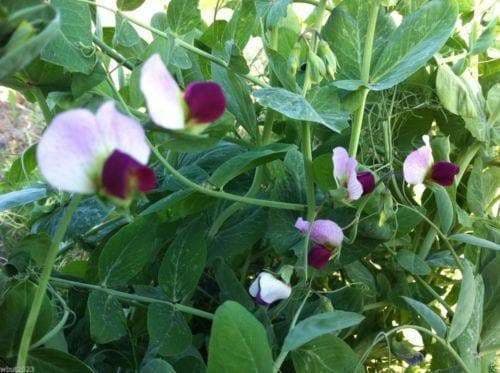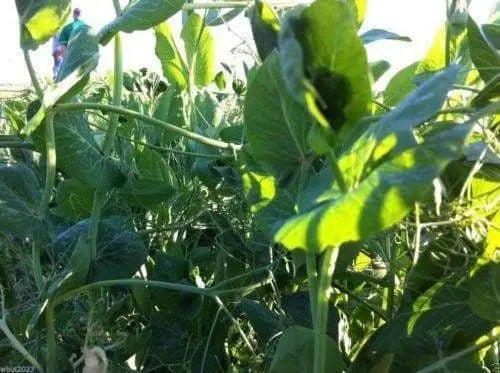
Austrian Winter Peas-Used As,Wildlife Food Plots,Cover Crops And Winter Grazing.
Most orders are processed by the next day
Select your desired size and/or color from the available options.
| Sowing Season | Seeding Depth | Seeding Rate (1,000 Sq. Ft.) | Seeding Rate (1 Acre) |
|
| Alfalfa |
Spring & Summer | 1/4 - 1/2" | 1/2 lbs. | 15-25 lbs. |
| Clover, Red | Anytime | 1/4 - 1/2" | 1/2 lbs. | 25-30 lbs. |
| Clover, Sweet | Spring & Summer | 1/4 - 1/2" | 1/2 lb. | 25-30 lbs. |
| Clover, White | Spring & Summer | 1/4 - 1/2" | 1/4 lb. | 5-15 lbs. |
| Cowpeas | Spring & Summer | 1 - 1/2" | 2 lbs. | 75 - 125 lbs. |
| Peas, Field | Spring or Fall | 1 1/2 - 3" | 3 lbs. | 100-150 lbs. |
| Soybeans | Spring to Summer | 1" | 4 lbs. | 150-175 lbs. |
| Vetch, Hairy | Anytime | 1/2 - 1 1/2" | 1 lb. | 25-50 lbs. |
Please Use Dropdown box to order !
Austrian Winter Peas
Pisum arvense) Close relative of Garden or English peas, but this variety is grown as a cover crop. As hardy as Hairy Vetch and good as a nitrogen fixer, but more adapted to drier or alkaline soil. Matures a bit earlier in spring from a fall planting. Very attractive to deer. Can be sown in early spring in cooler climates
Attracts: Deer, Turkey, Rabbits, and Quail
Origin: Common variety from Europe
Adaptations: Well-drained loam or sandy loam soils of the Southeastern US
Benefits: Adds nitrogen to soil and provides winter erosion control.
Nutrition: High quality, similar to White Clover.
Austrian Winter Peas Seed - Austrian winter peas are a great cool season legume crop for wildlife food plots, cover crops and winter grazing. Plant winter peas with a clover mix for a perfect fall winter plot. Austrian winter pea, sometimes called "black pea" and "field pea" is a cool-season, annual legume with good, nitrogen-fixing capabilities. This, and related pea species, are native to the eastern Mediterranean and western Asia. Early introductions eventually became established as a fall seeded crop in the southeastern states as far north and west as Oklahoma and in the coastal sections of Washington and Oregon. In modern times, Austrian winter pea has been well adapted to the Palouse areas of Washington, Idaho and Oregon. For more information on Austrian Winter Peas please call or contact us. Seed Rate: Broadcast Rate: 75 - 100 lbs. per acre Drill Rate: 50 - 70 lbs per acre Cover Crop: 100 - 150 lbs per acre .

Austrian Winter Peas are very good for cover crops and green manure crops, building tilth and adding organic matter and thus humus to the soil.
Peas like well drained and fertile loam soils. Field peas are used as a winter annual in the South and as a spring annual in the North for soil improvement and for forage. Generally grown with a small grain for pasture, hay or silage. Many cultivars have been available for use as a cover crop or green manure crop. Does not tolerate high water table or any substantial flooding.
Seed Depth: 1 - 2 inches pH: 6 - 7
Planting Time: Fall, Spring
Description
Austrian winter pea is a low-growing, viny legume which has been shown to fix over 200 pounds of nitrogen per acre per year under good conditions in Idaho. It has hollow, slender and succulent stems, 2 to 4 feet long. The foliage is pale green, and the flowers are colored, usually purple, pink or reddish. The leaf consists of one to three pairs of leaflets and terminal branched tendrils. Pods are 1.5 to 2.5 inches long with three to five round, dark-colored seeds. Seed color is commonly gray with purple or brown mottles. Seed size is fairly large with test weights of 55 to 60 pounds per bushel. Adaptation As the name implies, Austrian winter pea has good winter-hardiness and can be successfully grown fall-seeded in the intermountain region valleys, as well as in the Palouse regions of Washington, Idaho and Oregon. It has been grown fall-seeded with acceptable success in the Bozeman and Fort Benton areas of Montana. However, during severe winters, when the small pea plants are exposed to long periods of sub-zero weather without snow cover, they may be winterkilled. Austrian winter pea can also be grown spring-seeded as a summer annual in the areas mentioned above. Spring-planted Austrian winter peas should be seeded as early as possible in the spring at approximately the same time as spring wheat and barley. Successful crops were grown in the Bozeman area in 1987 with April 14 and April 19 seeding dates. Delayed seeding often reduces both the quality and yield of peas.
LET OUR CUSTOMER SPEAK FOR US

![[Seeds] - Caribbeangardenseed](http://caribbeangardenseed.com/cdn/shop/files/gift-card-gift-card-1_1024x1024_dfa857db-9150-4315-a362-7f0bb3fb9c47_60x28.png?v=1703978838)

